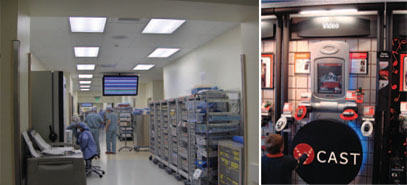- Digital signage means many things to different people. Usually it implies some sort of specialized content played over a network to a display device. Today, more likely than not, that display device is an LCD panel.
- In the early days of digital signage, plasma screens were larger and less expensive, and so they became the technology of
choice. Two of the major applications for digital signage were flight information displays and in-store retail applications. The content in both applications is predominantly static images and numbers, and the duty cycles can be demanding - 24/7 in airports and often 12 or more hours per day in retail. These demands revealed the weaknesses that afflicted early plasmas - mainly image retention ("burn-in") and excessive power consumption and heat generation.
Today, LCDs are available at larger sizes and lower cost, making them a viable alternative to plasmas. At the same time, plasma manufacturers have worked to resolve the perceived drawbacks of their technology. While the gap has not closed completely, it's fair to say that both plasma and LCD displays can be used in digital signage applications. Most experts, however, agree that LCD has the advantage in producing images in a variety of lighting conditions. And, of course, content always plays a role. If your images include lots of motion, you might opt for plasma. Plasma has an inherent advantage in pixel response time, which is the amount of time it takes for one pixel to go from active (black) to inactive (white) and back to black again. But if your digital signage content is primarily static or slowly changing images, LCD remains the preference according to most experts.
When shopping for an LCD panel for a digital signage application, don't be lured by the price-points and compelling demos at your local big-box retailer. There are important differences between consumer-grade LCDs and ones that have been designed and manufactured for commercial applications. Consumer use in a home is far less demanding on an LCD than a commercial digital signage application. Here are some other differences between commercial and consumer LCD panels.
Duty-Cycle: Digital signage is characterized by long hours of operation and extreme heat conditions. Airports, for example, are open all hours, which means their screens are almost never turned off. Commercial displays are designed to withstand long operating hours with thermal protection built into the internal design for proper heat dissipation. Commercial displays typically incorporate additional fans to dissipate heat. Consumer displays, on the other hand, are designed for limited on-time operation with the intent of long off-times. They are not appropriate for 24/7/365 operation environments.
Warranty: When consumer displays are used in a commercial environment, the warranty may immediately become null and void. In some cases, it will revert to 90 days over the counter, requiring the display to be shipped back or taken to a service center for repair. On the other hand, commercial displays from the major manufacturers like Samsung, LG, NEC, Pioneer, and a few others offer as much as a three years parts and labor warranty on site.
Connectors: Commercial displays recognize all PC resolutions, including wide formats and different refresh rates (1024x768 @60, 72, 75, 85 Hz) in addition to TV/video resolutions. Consumer displays are designed specifically for TV/video formats with very limited PC resolutions. One important differentiator is the connector interface. Commercial displays incorporate the standard RS-232 external control/connector with PC and video loop-through connector capability, facilitating multiple display configurations from a single PC or video source. In addition, they include industrial BNC locking connectors. Consumer displays typically do not offer RS-232 external display control/connector, video loop-through capability, or multiple display configuration capability, and they do not offer BNC connectors.
Image Orientation: Commercial displays are designed to operate in both landscape and portrait modes, allowing much greater flexibility in digital signage content options.
Security Features: Commercial displays take this into consideration and incorporate measures to protect controls in a public environment, including locking of front panel and IR remote lockout - while consumer displays offer no way to lock the controls.










